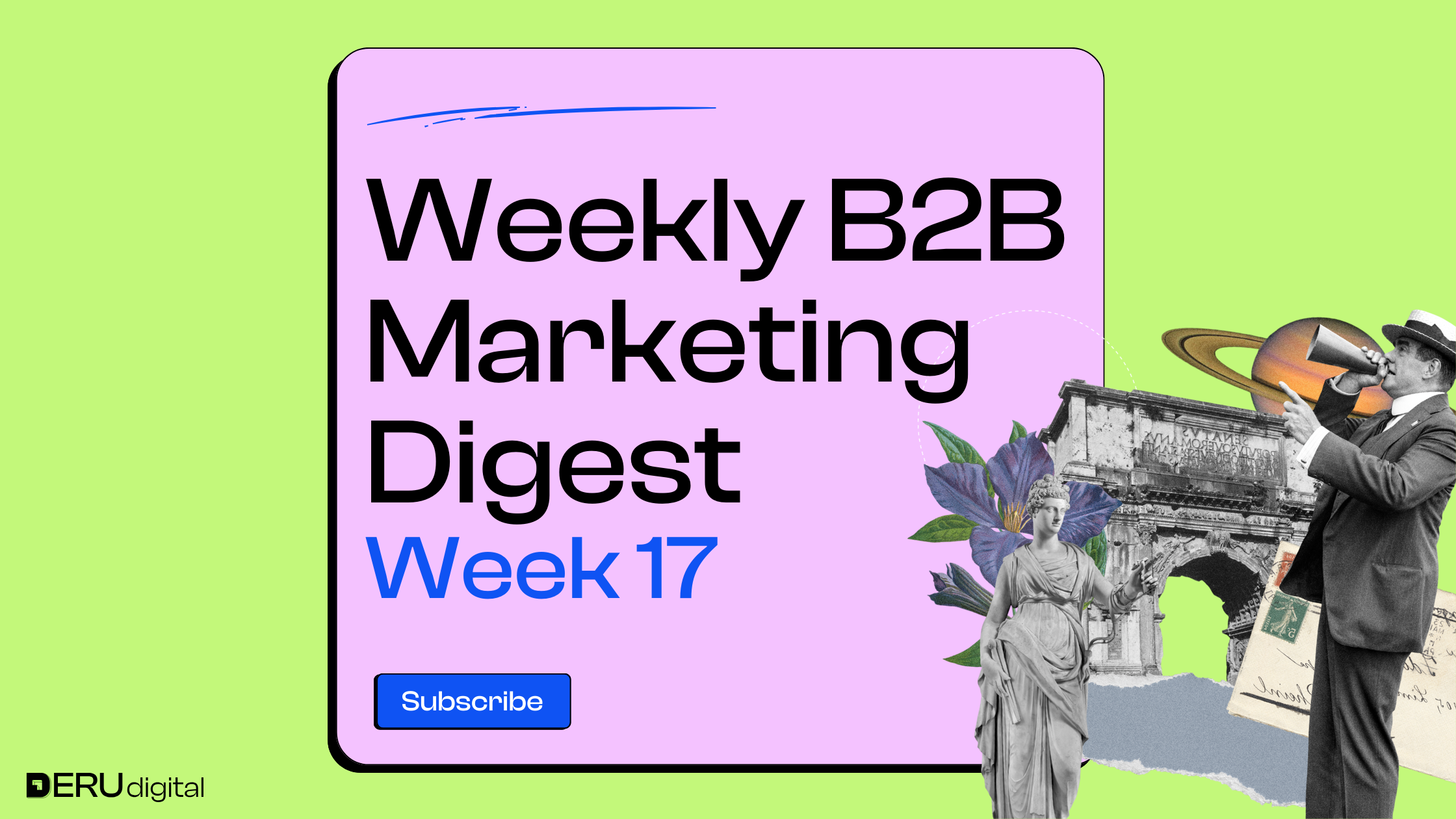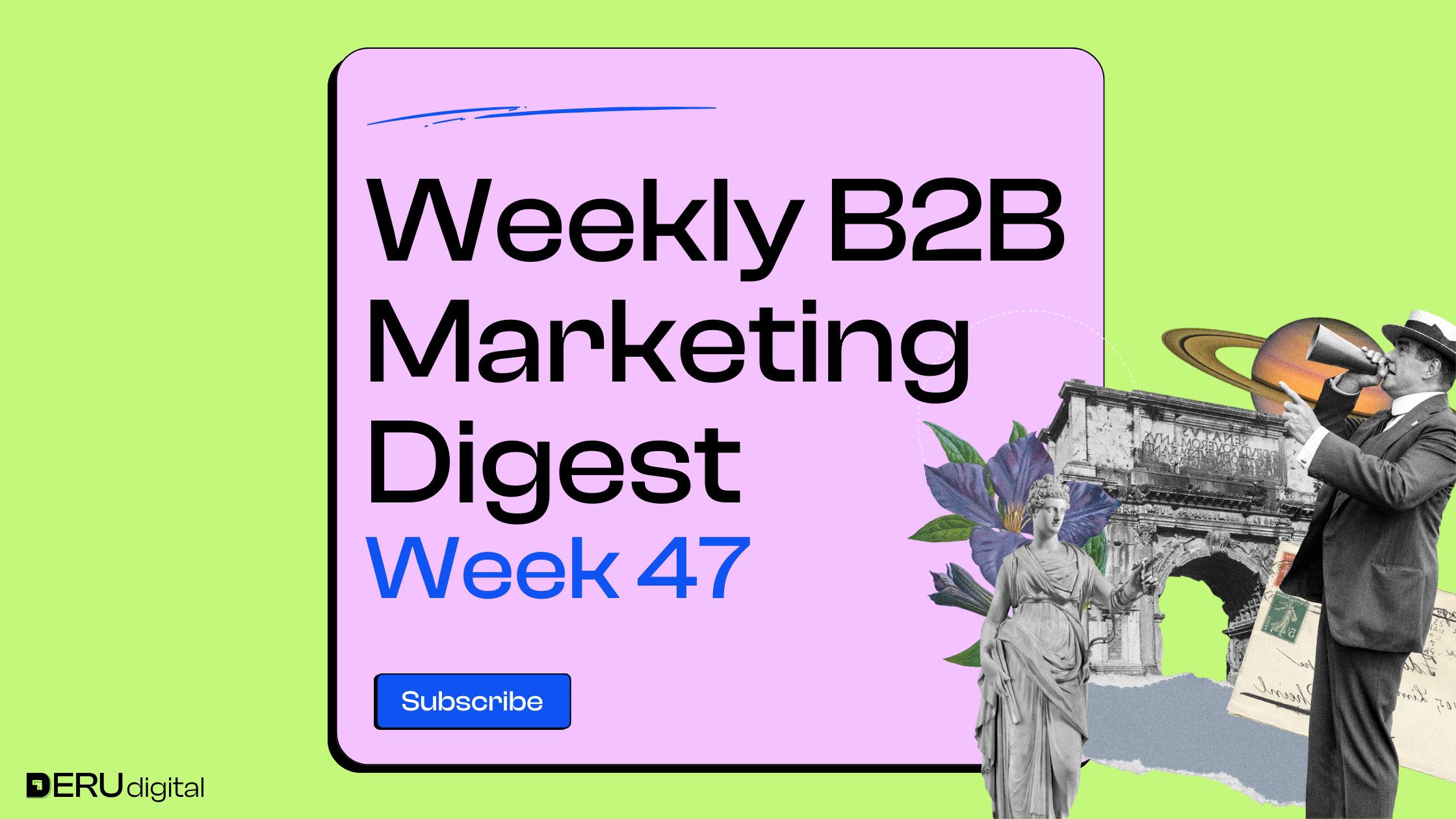
Check out the video here!
INSIGHTS FROM EXPERTS ON LINKEDIN
Andrea Todorova has reviewed over 12,000 B2B ad creatives to build Adfolio – a hand-picked library based on performance, peer feedback, and her own 8+ years in marketing. Last week, she added a bunch more, bringing it to 168 static ads, 61 gifs, and 40 landing pages. If you’re looking for actual examples that work, it’s worth checking out.

Tas Bober points out how wild it is that most B2B pages slap a form at the top without even answering basic buyer questions. Instead, she suggests leading with clarity – explaining what the product is, who it’s for, and why it’s different – before asking for an email. Build trust first, then make the ask.
Myra Ahmed explains that bad ad results often come down to boring, unrelatable copy. She recommends writing hooks that speak directly to how your audience is already solving their problems (even if it’s DIY or clunky old tools) – and then showing why your product is the better choice. Real talk wins attention.

Liam Moroney warns that when companies treat awareness as just a step to “move people along,” they limit their growth. Awareness isn’t a stage – it’s a standalone goal. Companies that obsess over funnels end up capping their potential. Big brands don’t create just enough awareness to feed sales; they go as wide as they can to own the market.
Elena Jasper digs into whether Excess Share of Voice (ESOV) is still a thing – and spoiler, it is, but it’s not as simple as it used to be. On her podcast, she chats with Dan Cleveland, VP of Strategy at Marketing Architects, about how ESOV still drives brand growth when done right. TV plays a big role, the math behind it is a little fuzzy (but usable), and if you’re spending more without seeing results, the problem might be your strategy – not the theory.

Dale W. Harrison explains the NBD-Dirichlet model in action: just because people say they prefer a brand doesn’t mean that brand dominates the market. Purchase frequency matters – heavy buyers (who buy a lot) shape the real outcomes, not just what surveys tell you. He uses examples like Salesforce vs. HubSpot to show why you need to think about both brand preference and buying behavior to really understand market share, especially in B2B.

Emilia Korczynska shares why she paused her website retargeting ads on LinkedIn – because they were wasting money on bad-fit accounts. She didn’t give up on retargeting, though. Instead, she lays out a smarter process using text ads, deanonymization tools like ZenABM, and CRM/account scoring to build a much cleaner, high-intent audience before spending. Bonus: it saves thousands of dollars on useless clicks from companies like Microsoft or Meta.

Ron Kohavi warns not to blindly trust A/B test results from Google Ads or Meta/Facebook. A new paper shows these “experiments” often aren’t properly randomized, which means they can’t prove causality. Instead, what we’re usually looking at are observational studies riddled with targeting confounds. If you’re basing decisions on platform A/B tests, it’s worth digging deeper- because they might be more misleading than helpful.

Kishalaya Mukhopadhyay breaks down Google’s new “Effectiveness Equation,” which models incremental sales based on impressions, not just spend. It highlights the classic S-curve of diminishing returns and why impressions data matters more than just dollars spent. He ties it to how Google’s MMM tool, Meridian, relies heavily on channel-by-channel impressions to predict marketing success more accurately.

WHAT'S NEW IN THE INDUSTRY
Small B2B SaaS companies often focus too much on short-term wins, missing the chance to build lasting brands. Jonathan Bland of Omni Lab stresses the importance of balancing direct response with long-term brand marketing, using principles like the 95-5 rule, strong messaging around buying triggers, and standout creative assets. Future success depends on engaging future buyers early, creating emotional connections, and adapting to trends like founder-led content, B2B influencer marketing, and responsible use of AI.

Google is changing how ads show up in search results, now allowing advertisers who appear in top ad spots to also show relevant ads at the bottom of the page. They updated their unfair advantage policy to clarify this isn’t considered double serving and say early tests showed better user experience and a 14% increase in bottom ad conversions. Advertisers should expect more opportunities and are encouraged to review their keyword and creative strategies to maximize performance.
Google decided not to roll out a new consent prompt for third-party cookies in Chrome, maintaining the current setup and providing short-term stability for advertisers. While Privacy Sandbox initiatives like IP Protection continue, broader privacy changes are still on the horizon, meaning reliance on first-party data remains crucial. The Privacy Sandbox project faces technical hurdles and industry skepticism, leaving its future direction uncertain.
Google is introducing new beta channel controls for Demand Gen campaigns, allowing advertisers to choose where their visual ads appear across YouTube, Gmail, Discover, and the Google Display Network. This move gives marketers better creative targeting, especially with YouTube Shorts, and more detailed performance reporting by platform. While manual placement is now possible, Google still recommends automatic channel selection for best optimization.
Google Ads has introduced a new Tree Table View that organizes reporting data into easy-to-read hierarchies, helping advertisers better understand complex campaign structures. The feature improves navigation and insight discovery by visually stacking and nesting dimensions like campaign type and status. It’s rolling out gradually and can be accessed through the “Generate Report” beta feature.

Google Ads API v17 will stop working on June 4, and advertisers still using it must upgrade to avoid disruptions. Businesses should check their API usage and migrate to the latest version immediately to ensure campaign management and reporting continue smoothly. Delaying the upgrade could cause serious outages.
Meta is officially rolling out ads globally on Threads, giving brands access to its 300 million monthly active users through familiar targeting tools. Image-based ads will appear between posts, and Threads placements will be enabled by default for new Advantage+ and manual campaigns. This move signals Meta’s confidence in Threads as a serious new revenue stream and advertising platform.

Google has updated its Local Services Ads terms, giving itself the right to use, modify, and analyze all advertiser content – including recorded phone calls. This raises major privacy concerns, especially for sensitive industries like legal and healthcare, where confidential information could be captured and processed by AI. Advertisers must accept the new terms by June 5 or risk having their LSAs paused.
That’s the scoop for this week! If you found this valuable and any useful insights caught your eye, feel free to share them with your network.
Until next week!



